We use webinars for absolutely everything in our business.
Lead generation? Check.
Conversion? Absolutely.
Delivering content? You bet!
Webinars have made a MAJOR difference in our marketing.
I would say the one place where I couldn’t live without a webinar is for selling products, especially high-ticket offers. For me, offers above $500 are immensely easier to convert using a webinar than other methods.
So today, I’m going to give you the steps I use for my webinar sales strategy.
I’ve been doing webinars for over a decade, and WOW – technology has totally transformed the game! But the foundations of a solid webinar remain the same—whether it’s live, evergreen, paid, or free. Name it!
But before we dive in, let’s fully digest how webinars help you SELL MORE.
Are Webinars Effective for Sales?
The answer is a big YES!
We’ve built a multi-million dollar business just by opening our laptops and doing a quick webinar.
But it’s not just us. 73% of B2B marketers and sales leaders consider webinars the top strategy for producing high-quality leads.
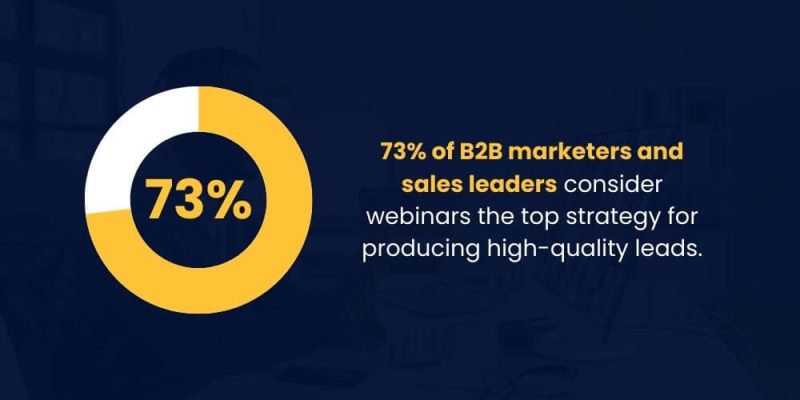
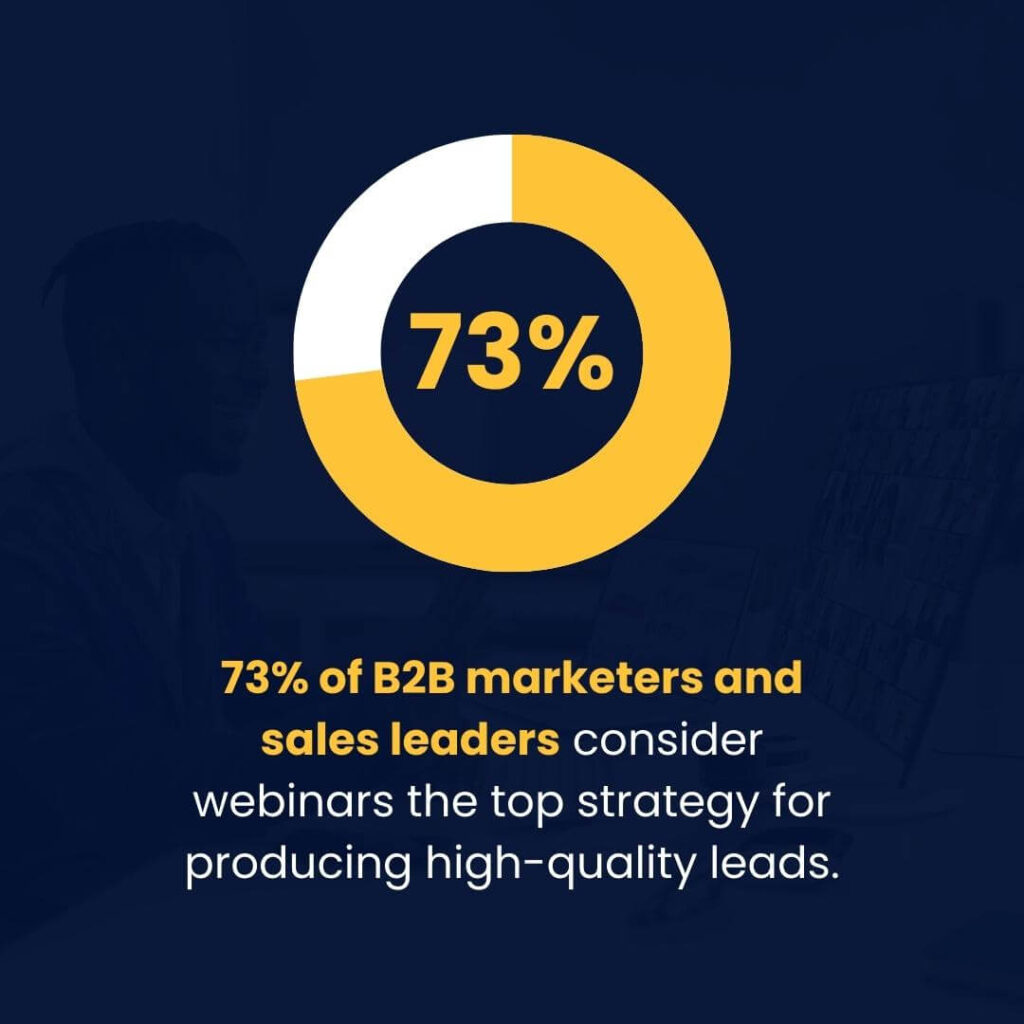
So what is it that makes webinars such a POWERFUL sales tool?
AUTHENTICITY.
I see people go through a LOT of headaches trying to create a fancy sales video. But believe it or not, sometimes, the most straightforward presentations work the best.
Webinars keep it real. I don’t even need to have pretty slides to impress people. Sometimes, all I have is a document, and I would write on the document as I talk.
Your webinar attendees can ask questions about your product, and you can provide more in-depth answers. The event becomes an interactive experience that allows you to connect with your prospects.
And in case you’ve forgotten—SALES is all about HUMAN CONNECTION.
From Zero to $57.9 Million Dollars in Webinar Sales

I’ll give you a prime example from my good friend, Jason Fladien a.k.a Mr. Webinar.
Jason and his team at Rapid Crush, Inc. went from zero to $57.9 million dollars with a brand-new digital offer in the crypto space in just 226 days using webinars. BEYOND incredible, right?
What’s Jason’s elaborate strategy for delivering his ultra-successful webinar? Just being authentic.
By developing an offer that nobody else was offering in the market and getting it out quickly, Jason and his team got genuine insights from real-world customers.
Offering a beta version at a huge discount allowed Jason to test messaging, angles, and sales tactics to maximize his success.
Just being “raw” in your webinars doesn’t guarantee that you’ll be able to replicate Jason’s results.
You still need to have an IRRESISTIBLE offer and you must do your homework so you get the right audience into your webinar.
Jason’s experience shows that sometimes you have to fly the plane while you’re building it. And webinars are the perfect platform for that.
Webinars let you gauge immediate feedback, handle objections on the spot, and pivot your strategy based on the audience’s response.
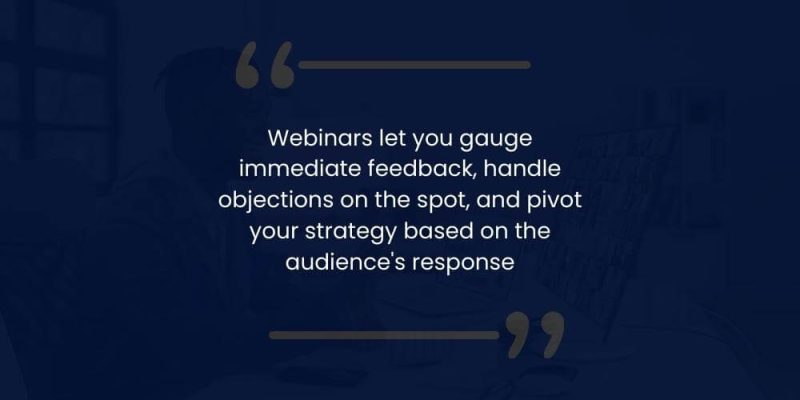
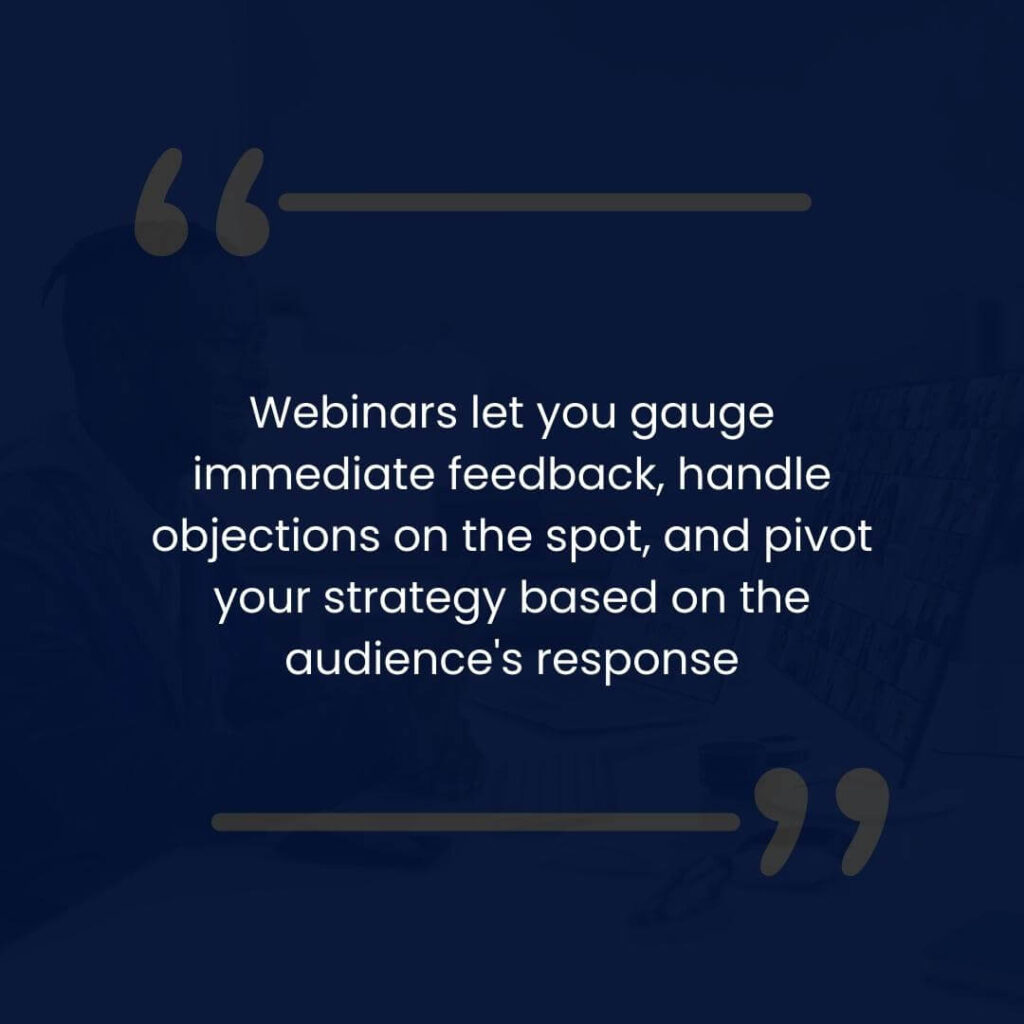
Jason’s approach wasn’t about putting out a half-baked product and hoping for the best. It was about being upfront that the product was in beta and that early adopters would get red-carpet treatment at a huge discount.
This honesty built trust and created a sense of community among early adopters.
Want to watch the entire interview? Check out the video below.
How to Convert Webinar Attendees into Sales
Now that you’re sold on webinars, how can you actually put them to work for your business?
My webinar sales strategy will guide you.
Sure, there’s flashy new tech that comes out every month to simplify marketing, but the real secret to boosting your webinar sales? Much of it still boils down to the basics.
Let’s go through them one by one.
Select a Relevant Webinar Topic
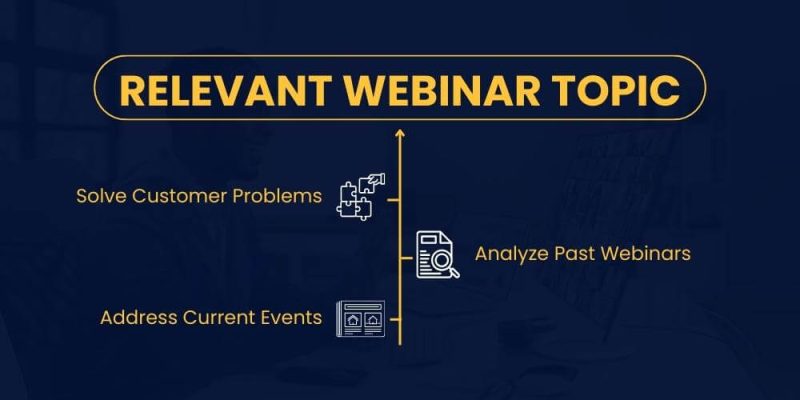
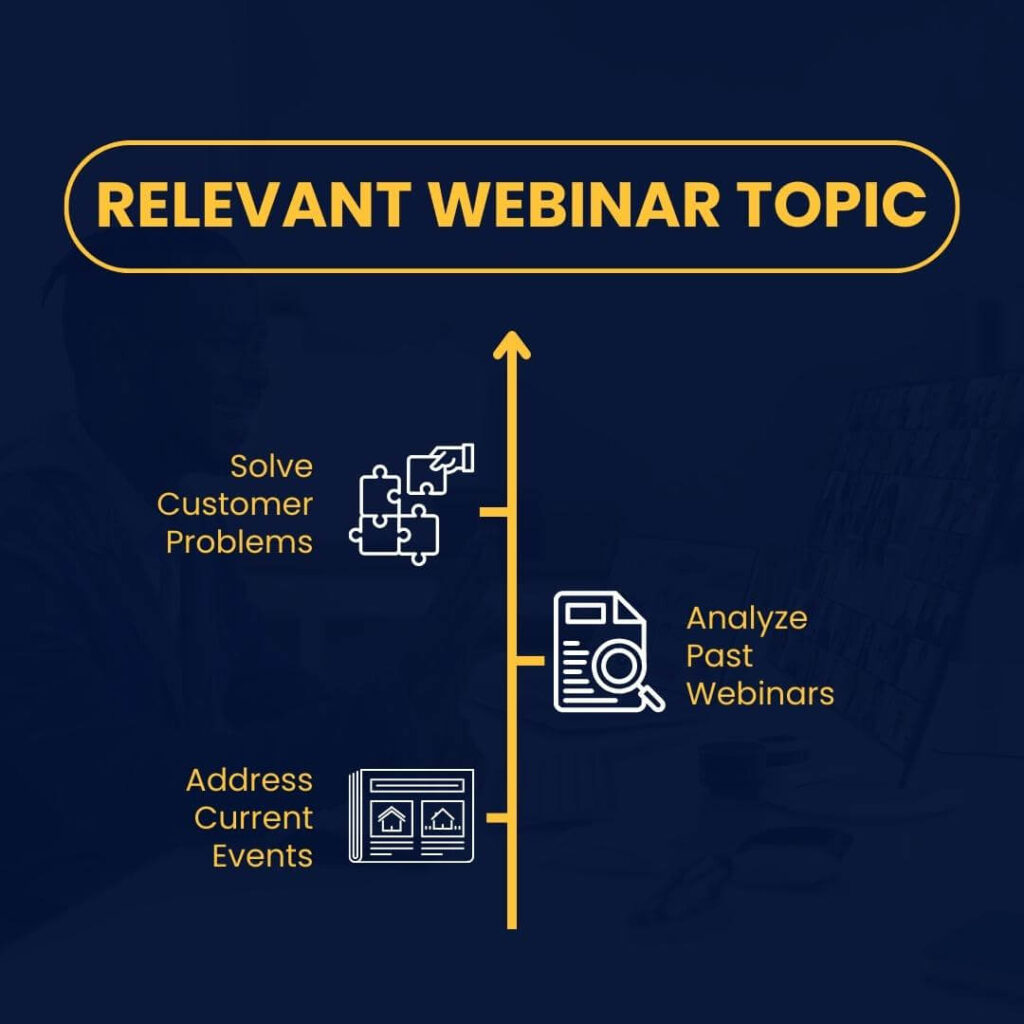
Your webinar topic doesn’t just attract an audience; it draws in the right audience, hungry for what you offer.
If you can zoom into a targeted audience, you’re more likely to get warm and hot leads—people in the consideration or decision phase of the buying process. They need your product and are ready to convert.
So, how do you select a relevant topic for your next webinar?
Here are a few places where you can start:
1. Solve Customer Problems
Let’s be clear: your webinar is not about you. It’s about your audience.
Nobody tunes into a webinar to hear about your achievements. They’re tuning in because they have a problem they believe you can solve.
What are their needs, pain points, and interests?
For instance, I give a webinar on building a 10,000-subscriber email list targeting small businesses that need strategies for growing their list and turning it into actual clients.
Jason’s webinar addresses the pain points of people investing in cryptocurrency and who need tools and strategies for crypto automation.
If you’re selling dog training courses, research the interests of your target customers – like dog psychology, dietary needs for different breeds, or leash training to prevent pulling and then make a webinar on that topic.
Your objective? Be the go-to expert of your target audience. If you do it it right, by the time you’re done with the webinar, you’ll have people hanging on every word, primed for the action you want them to take.
2. Analyze Past Webinars
If you’ve hosted several webinars, you don’t need to look far for clues for your next topic. Experience is the best teacher.
So GO. Dig into your data.
These are the metrics I focus on for my webinars:
- Attendance Rates: Review the number of registrants versus attendees. A high attendance rate indicates that the topic was compelling enough for your attendees to prioritize and show up.
- Questions asked: Did your attendees actively engage with you by asking questions? This shows they were invested in your content. Were there topics that participants requested more information on? Round up the top three requests and make webinars on that.
- Polls and survey participation: If you had in-webinar polls or post-webinar surveys, use those to determine your next topic.
- Chat activity: Were your attendees discussing the content among themselves or with you in the chat?
Here’s the takeaway…
Know your audience! Check the attendance and engagement rates of your webinars. This shows you the topics and formats your target customers prefer. Use this insight to shape your upcoming content to their interests.
3. Address Current Events
Remember, you’re the go-to expert. So that means people go to you for answers whenever there’s a big shakeup in your industry.
Me? I’m a MASTER of segmentation in email marketing. I’ve been at it for 20+ years and have collected MILLIONS of emails. Just one of my Sendlane accounts has over 2.5 million contacts in it.
I get asked ALL THE TIME what new strategies work for email engagement or how to run email campaigns.
My team and I do a LOT of testing, so when we have new insights on what steps are actually worth implementing, we use that for topics for our webinars.
And guess what? These new discoveries drive registration and engagement like CRAZY!
Create a Dedicated Landing Page
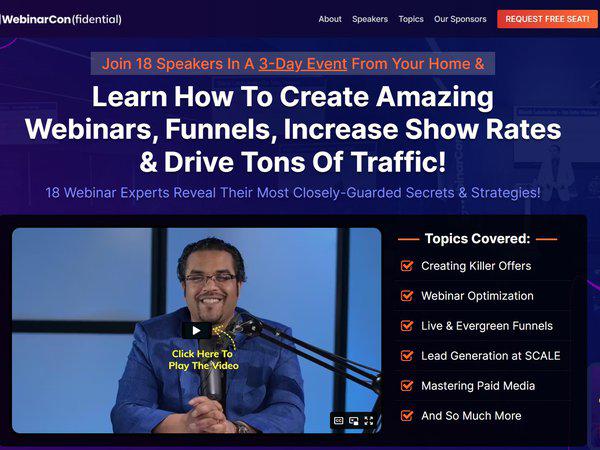
I see too many marketers botching their landing page with copy like they’re trying to make the New York Times Best Sellers list.
What you need is a concise, well-designed landing page that provides people with a clear next step. For webinar attendees, this might be to sign up for a service, purchase a product, or download additional content.
What’s my rule of thumb for creating landing pages?
It’s KISS (Keep It Simple, Stupid).
Webinar ninja and friend Jon Penberthy does the same for this webinars. Jon’s automated webinar system has generated over $4 million in the last few years and consistently makes around $200,000 monthly.
No, he doesn’t have a flashy landing page full of logos, testimonials, and over-the-top copy.
He keeps it simple:
- A headline
- A few bullet points
- Images
- A button to register
Jon has done several A/B tests to find the most effective strategy for his landing pages, and they’ve seen a simple, straightforward design is the most effective.
Now, these are Jon’s results and what he’s found as the method that fills their webinar calendar.
Yours might be different. It’s about testing to see what works best.
Learn more about Jon’s approach for a high-converting webinar funnel.
Introduce Your Offer: Permission-Based Pitching
Webinars have become so popular that everyone and their mother has one these days.
But here’s the thing: SO MANY people have absolutely NO CLUE how to pitch during their webinars.
I’ve been in webinars where they even tried to hide the fact that they’re selling something.
I got news for you—people who sign up for your webinar know you’re going to pitch them. What’s wrong with that?
Listen, people are fine being pitched to if they know they’ll get VALUE even if they don’t buy.
So, this is how you can do your webinar sales pitch.
In the days leading to your webinar and during the webinar itself, let your attendees know that you’re going to be delivering VALUE. This is what I call Permission-based Pitching, and I use it all the time in my webinars.
I’d say something like—
“Listen, I’m going to deliver tons of value to you, but at the end, I do want to make you an offer. Is that OK? I’ll let you know exactly when I’m about to make you an offer, and you can choose to stay or go. But the value today is going to be amazing as well.”
Remember, it’s not just a pitch-fest. The idea is to be transparent and honest, so you become more relatable and gain people’s TRUST.
Trust builds long-term customer relationships and helps reduce their objections to buying your products or services.
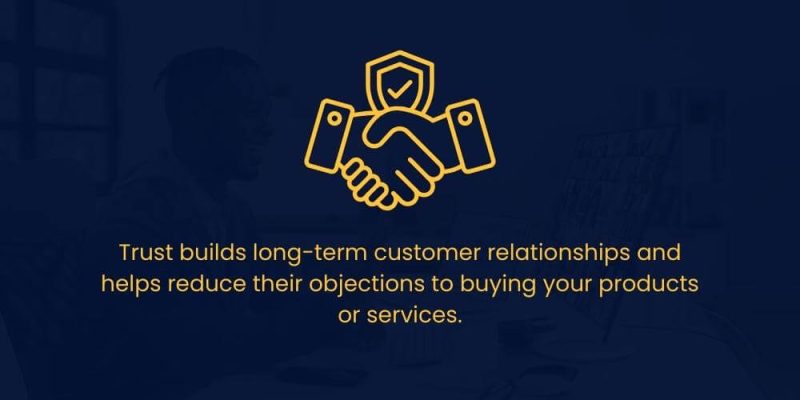
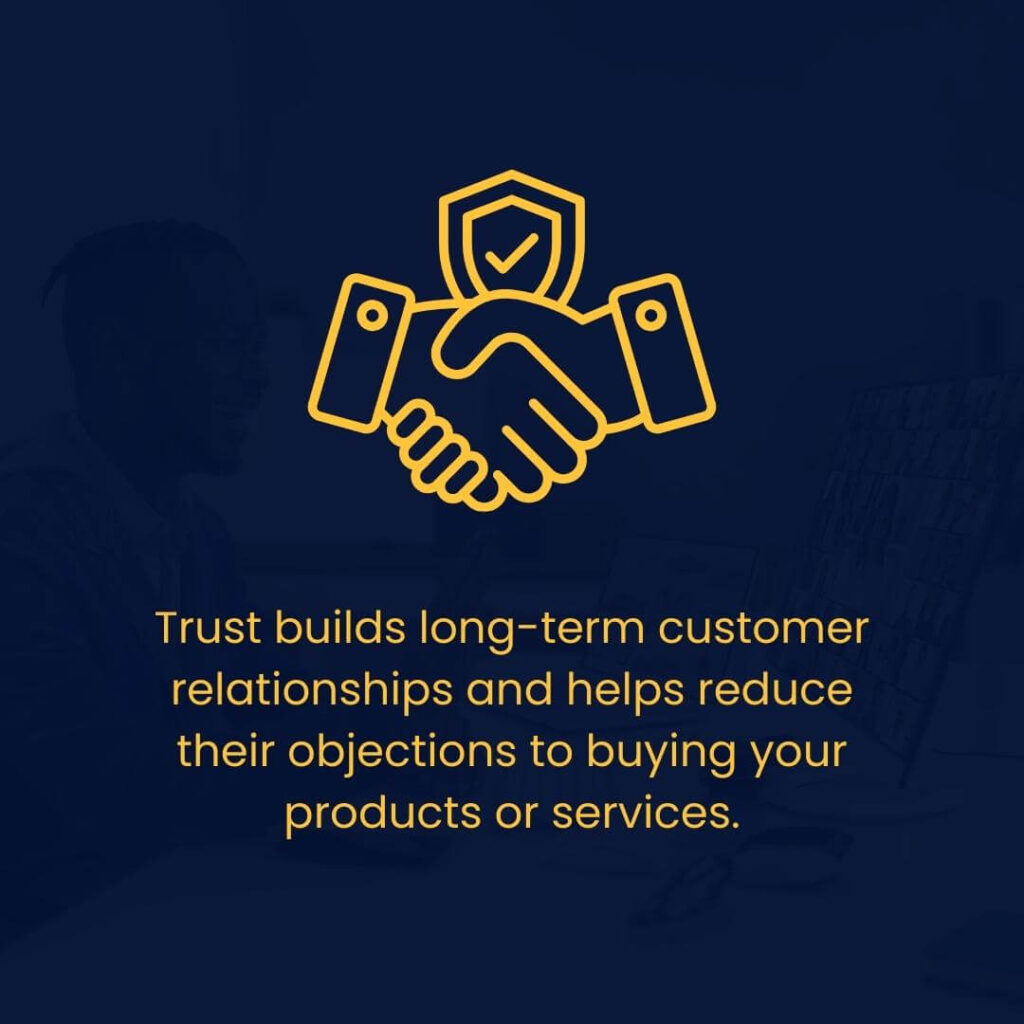
Sprinkle Micro CTAs throughout Your Webinar
There’s a trick to making your CTAs more COMPELLING.
Psychology. Psychology. Psychology.
Instead of giving one CTA toward your webinar sales pitch, use tiny actions throughout your webinar.
This is what I mean.
In every webinar or video I post, I tell the audience to do a simple act.
- Type a 1 in the chat…
- Give me a YES…
- Write “ME” if this sounds like you…
This technique takes some time to get used to. As you give more webinars, you’ll get the hang of it, and it becomes second nature.
So why does this trick work?
I’m constantly telling the audience what to do.
With tiny baby steps, I’m getting the audience used to doing what I ask..
Not only does it train your audience to listen to you. It also aligns them with your primary CTA. Those are messages that are getting seeped into the subconscious mind.
So when it comes time to purchase, and I say, “Buy now,” the audience is used to doing what I’ve been saying throughout the webinar!
Also, using this technique just makes the webinar more FUN! Who wouldn’t like that?
It’s nice to constantly get feedback from your attendees so you don’t feel like you’re talking to a wall!
Follow up After the Webinar: Advanced Segmentation
No matter how well you present your webinar sales pitch, there will always be “fence sitters.”
This is especially true for mid to high-ticket products. A lot of people need to take their time before they buy.
But remember, momentum is everything. That’s why your follow-up after the webinar is as important as any other part of your webinar sales strategy.
This is where I use the power of segmentation.
After a webinar, I send personalized emails based on the registrant’s specific actions. I do this to get people in the loop and re-engage those who may have been ignoring my emails for some reason.
Here’s what I do:
I segment webinar attendees into three types of recipients:
- Those who didn’t open the email.
- Those who opened the email but didn’t click.
- Those who clicked but didn’t take the intended action.
Let’s say I’m emailing all those who didn’t even open my email about the webinar replay. The subject line can be something like, “Hey, what happened?”
That’s it. That sends my open rates through the rough because that’s how friends talk to each other. It triggers a natural reaction to the subject line, and the recipient opens the email.
I see too many marketers not doing advanced segmentation because they don’t want the extra work.
But trust me, taking the extra 15 minutes to send out personalized emails will set your post-webinar sales strategy apart from thousands out there.
Tips for Hosting Webinars That Increase Sales
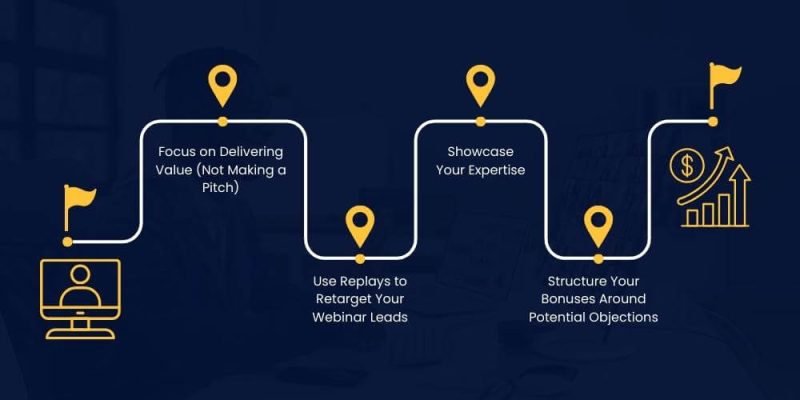
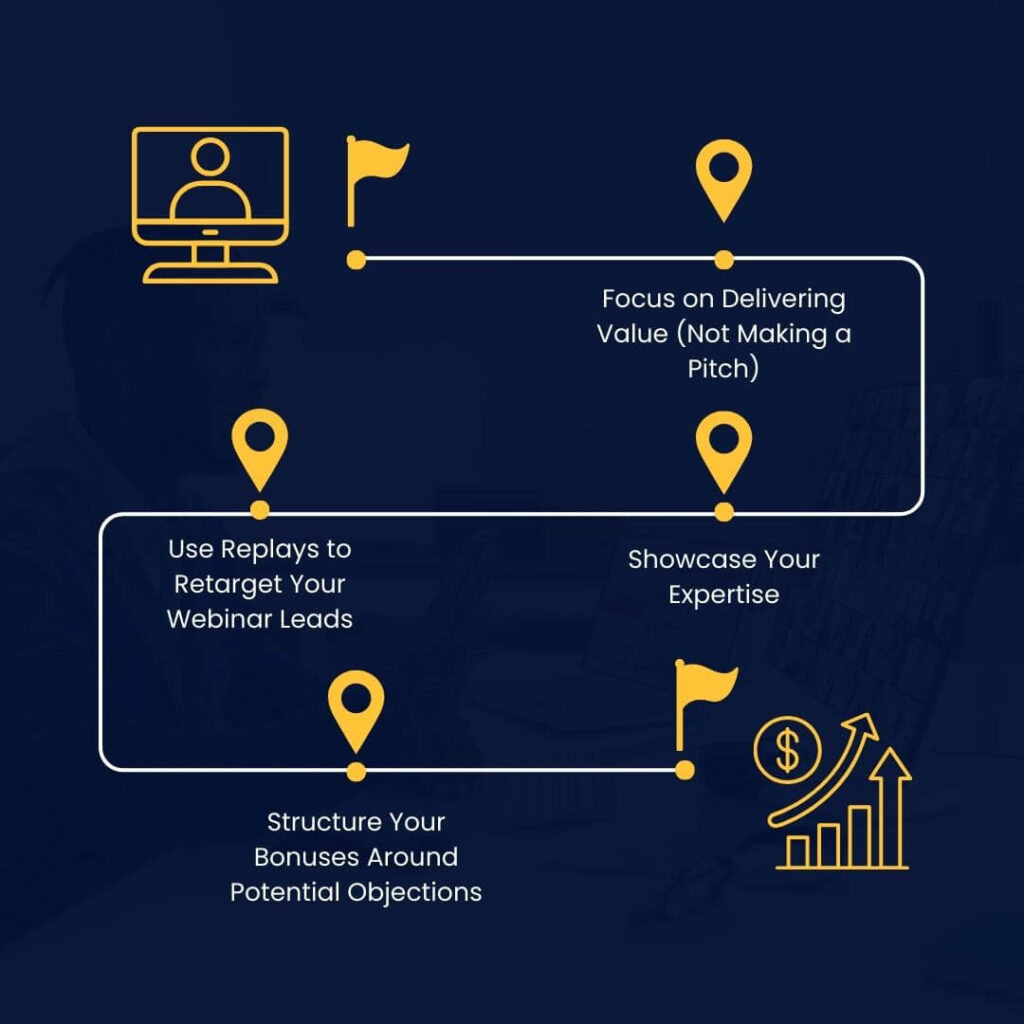
I’ve got a few more tricks to turn your next webinar into a sales-generating machine.
Let’s look at my personal favorite—delivering value.
Focus on Delivering Value (Not Making a Pitch)
VALUE FIRST.
I’ve been preaching that in our Facebook group forever and believe in it wholeheartedly.
So much of the “content” I see these days is just fluff, generic, or rehashed content.
Don’t be that person.
Teach your audience real insights you discovered about your work or industry. Do this, and your webinar will be 10x more impactful when you make your webinar sales pitch.
I’m not saying you have to give away your secret sauce, but your audience needs to have an “ah-ha” moment. They need to LEARN something.
How do you know if your content is valuable or fluff?
Simple. If you’re questioning, it means it’s not good. Sorry.
I’ll tell you a nifty way to communicate value in your webinars—be specific.
Instead of saying, “You’ll receive 10 modules on how to grow your business,” say, “You will learn 10 steps to grow your business in 10 days.”
When your audience knows exactly what they’re going to get, it addresses their problems, and they can implement it immediately, then that’s tangible value they can’t get elsewhere.
Showcase Your Expertise
Don’t undervalue the Q&A at the end of your webinar sessions. Q&As are the perfect place to show your expertise and gain the trust of your audience.
I had a Q&A where I stayed on for an hour and a half after I did my webinar pitch.
I answered questions in detail.
I helped people overcome their objections and aimed to make them feel confident that our offer was right for them.
And guess what? More than 50% of my audience was still there at the end of the Q&A.
My team and I went back to track that Q&A to discover that 25% of our sales we were able to draw in during the Q&A time!
If I had not invested that extended time in Q&A, I could have lost 25% of sales!
So, don’t kid yourself and think that everyone makes the decision at the offer.
Remember those fence sitters I told you about? Your Q&A could help them stop sitting around and make the purchase.
Use Replays to Retarget Your Webinar Leads
Retargeting is a great post-webinar engagement tactic in our webinar sales funnel.
Remember, while not every attendee purchases immediately after your webinar, a whopping 91% WILL search for more details.
Retargeting can be an effective way to bring them back to your website, Facebook page, or have them sign up for a low-ticket offer to start.
Webinar replays are excellent for retargeting, but we ALWAYS put an end date on replays. We make this sufficiently clear in all our marketing.
We have found that in the last few years, the response to replays isn’t as strong as it was maybe five years ago.
With so many replays going around every single day, people get desensitized and don’t take action.
Hence, the end date.
You have to build scarcity. Take down your replays after a couple of days, and people will watch it like nuts!
So, how long should you have your replay up?
48 hours is a good rule of thumb. After that, send two or three emails guiding the leads to the sales page.
This may not be best for your webinar, so keep testing your results until you find the sweet spot for your replays.
Structure Your Bonuses Around Potential Objections
Most people make the mistake of just creating good bonuses—things that sound sexy and add excitement to the core offer.
I’m totally on board with that.
But there’s another way you should be using bonuses.
Use them as CLINCHERS, not just add-ons.
When you structure your bonuses around possible objections, you directly address the hesitations and barriers a potential buyer might have. Doing so can make it easier for them to take out their credit cards.
For example, a common thing that holds back people is time commitment.
And I know this from the hundreds of hours of webinars under my belt.
People may hold back because of the price. But often they don’t know if they can actually sit down and implement what we teach.
Consider offering a bonus tailored to this problem. Something like a series of free “Quick-Start” guides and video summaries would allow your audience to grasp core concepts and start implementing what they learned without getting overwhelmed.
The bonus is not an “extra”—it’s VALUABLE in itself. It enhances the offer and provides solutions to the very reasons someone might say no. Using bonuses this way allows you to kill two birds with one stone.
What Comes Next?
At the end of the day, webinars are sales tools. That’s why you have to nail your webinar sales strategy.
Use the steps and tips I provided to optimize our webinar so that you can convert better.
You don’t have to apply them all at once. Pick one or two you can implement in your next webinar and compare your results.
TEST. TEST. TEST.
Want more insights like the ones I shared in this post? Join my FREE Expert Scale Facebook group.
Ask questions and share learnings with fellow entrepreneurs raking in MASSIVE success with their businesses.
See you on the inside!